Chapter 3. Digestion, Absorption, and Elimination
The Gastrointestinal Tract and the Digestive System
What Happens to the Food You Eat?
When you ingest food, a 3-part process takes place:
- Digestion: The process of breaking down food into smaller molecules, which can occur mechanically or chemically.
- Absorption: The process of taking these smaller molecules from the gastrointestinal tract through the intestinal wall and into the circulation (e.g., blood or lymph).
- Elimination: The removal of undigested or unabsorbed food and waste products.
Once you have eaten, your digestive system starts the process that breaks down the components of food into smaller components that can be absorbed and taken into the body. To do this, the digestive system functions on two levels, mechanically to move and mix ingested food, and chemically to break down large molecules. The smaller nutrient molecules can then be absorbed and processed by cells throughout the body for energy or used as building blocks for new cells.

Digestion converts components of the food we eat into smaller molecules that can be absorbed into the body and utilized for energy needs or as building blocks for making larger molecules in cells. Nutrients, as well as some non-nutrients, are absorbed. Anything that isn’t absorbed into the body, such as fibre, is excreted/eliminated.
The Gastrointestinal (GI) tract
The GI tract is a tube-like structure that starts at the mouth and ends at the anus, including everything in between.

There are several distinct sections of the GI tract that play a role in digestion, absorption, and elimination:
- Mouth
- Esophagus
- Stomach
- Small intestine
- Large intestine
Movement between these sections is controlled by sphincters, which are rings of muscle that respond to nerve signals, causing them to open or close. Smooth muscle tissue surrounds the GI tract and its contraction produces waves, known as peristalsis or haustration, that propel food through the tract.
Several accessory organs also play a role in the digestion and absorption of nutrients:
- Salivary glands
- Liver
- Pancreas
- Gall bladder
The GI tract is lined with mucosal tissue that secretes digestive juices (which aid in the breakdown of food) and mucus (which facilitates the propulsion of food through the tract).
From the Brain to the Stomach
The Cephalic Phase of Digestion
The process of digestion begins even before you put food into your mouth. The cephalic phase of digestion begins when you start thinking about food. When you feel hungry, your body sends a message to your brain that it is time to eat. Sights and smells influence your body’s preparedness for food. Smelling food sends a message to your brain. Your brain then tells the mouth to get ready, you start salivating, and your stomach starts secreting gastric juices in preparation for your meal. Specifically, the cells lining the stomach will secrete the hormone gastrin, which stimulates the gastric glands to secrete digestive juices.
The Mouth
In the mouth, where the second step of digestion starts, the mechanical and chemical breakdown of food begins. The chemical breakdown of food involves enzymes such as salivary amylase, which starts the breakdown of large starch molecules into smaller components, and lingual lipase, which initiates the breakdown of lipids.
Mechanical breakdown starts with mastication (chewing) in the mouth, which moistens the food, increases its surface area, mixes it together, and stimulates the production of saliva. Saliva provides lubrication and enables food movement downward. The slippery mass of partially broken-down food is called a bolus, which moves down the digestive tract as you swallow. Swallowing may seem voluntary at first because it requires conscious effort to push the food with the tongue back toward the throat, but after this, swallowing proceeds involuntarily, meaning it cannot be stopped once it begins. As you swallow, the bolus is pushed from the mouth through the pharynx and into a muscular tube called the esophagus. As the bolus travels through the pharynx, a small flap called the epiglottis closes to prevent choking by keeping food from going into the trachea.
Digestive Enzymes
Enzymes play a key role in chemical digestion.
- Amylases break down carbohydrates
- Lipases break down lipids
- Proteases break down proteins
The Esophagus
In addition to the epiglottis closing, the upper esophageal sphincter (a sphincter at the top of the esophagus; Figure 3.4 “The trachea, the esophagus and its associated sphincters”) needs to open, to allow the bolus to enter the esophagus. The esophagus is a muscular tube connecting the pharynx (throat) to the stomach and transports the bolus of food between these two sections. In an action known as peristalsis, the muscles of the esophagus contract to squeeze and push the food bolus down to the stomach (Figure 3.5 “Peristalsis in the esophagus”).
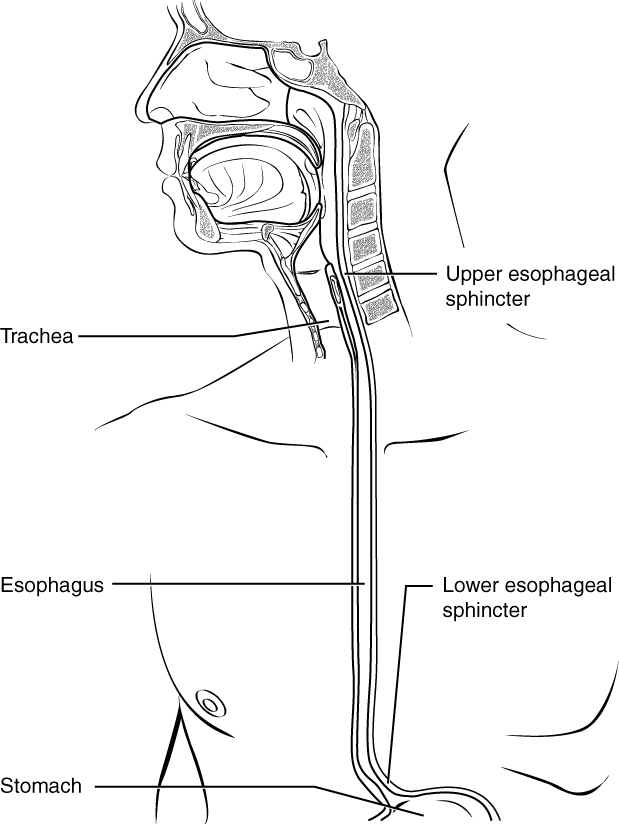
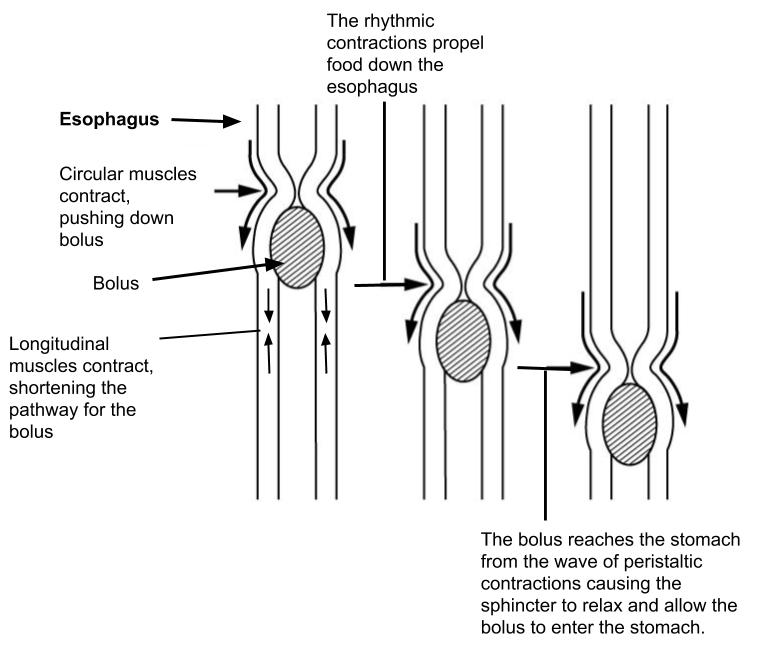
The Stomach
At the junction between the esophagus and stomach, there is a sphincter muscle, known as the gastroesophageal (or lower esophageal or cardiac) sphincter (Figure 3.4) that remains closed until the food bolus approaches. The pressure of the food bolus stimulates the lower esophageal sphincter to relax and open, allowing the food to move from the esophagus into the stomach. Solid food takes between four and eight seconds to travel down the esophagus, and liquids take about one second. When food enters the stomach, a highly muscular organ, powerful peristaltic contractions help mash, pulverize, and churn food into chyme, which is a semiliquid mass of partially digested food that also contains gastric juices. Even before the food arrives at the stomach, the cells lining the stomach will secrete the hormone gastrin, which stimulates the gastric glands to secrete digestive juices. Gastric glands contain two cell types, parietal cells and chief cells, that produce the components of gastric juice listed below:
| Parietal Cells | Chief Cells |
| Hydrochloric acid: important for protein denaturation, killing bacteria/ germs, and activating pepsinogen into pepsin | Secrete pepsinogen, pepsinogen is then converted to pepsin by hydrochloric acid, which is important for protein digestion. |
| Intrinsic factor: important for vitamin B12 absorption | Gastric lipase: important for lipid digestion |
The length of time food spends in the stomach varies by the macronutrient composition of the meal. A high-fat or high-protein meal takes longer to break down than one rich in carbohydrates. It usually takes a few hours after a meal to empty the stomach contents completely into the small intestine. Minimal amounts of water, minerals, and drugs are absorbed in the stomach as the majority of absorption takes place in the small intestine.
If the stomach contains acid, why doesn’t the stomach lining always erode?
Gastrointestinal Disorders: Heartburn and Gastroesophageal reflux disease (GERD)
When the gastroesophageal sphincter remains partially opened, this may cause gastric juice, which contains hydrochloric acid, to seep back into the esophagus. This can result in feelings of heartburn, or if it is more painful, frequent, and persistent, it can be classified as GERD. To try and reduce GERD, people are advised to identify triggers and avoid them, eat smaller meals, wait for a few hours before lying down (and consider raising their head), or take medications (e.g., antacids or proton pump inhibitors). If left untreated, scar tissue can develop in the esophagus, making it hard to swallow and even aggravating asthma.
The Small Intestine and the Accessory Organs
From the stomach, chyme passes into the small intestine with the pyloric sphincter separating these two sections (Figure 3.6). The small intestine is divided into three structural parts: the duodenum, the jejunum, and the ileum (Figure 3.7).

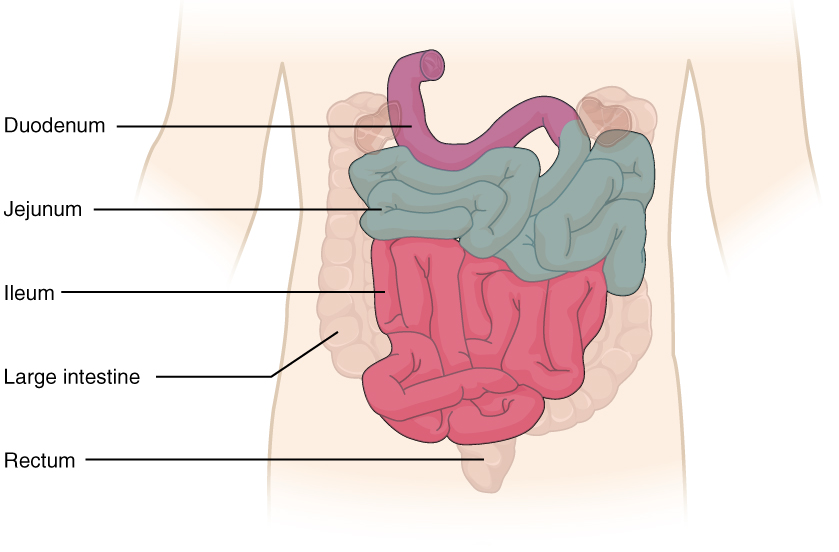
The Accessory Organs: The Liver, Pancreas and Gall Bladder
Chemical digestion in the small intestine relies on 3 key accessory organs: the liver, gall bladder and pancreas. Once the chyme enters the duodenum (the first segment of the small intestine), this signals the release of secretin; the presence of protein and fat in the duodenum also signals the release of cholecystokinin (CCK) into the duodenum. This in turn signals the pancreas and gallbladder to release juices that assist in digestion.
Specifically, following CCK secretion, the gallbladder secretes bile (which is made in the liver but stored in the gall bladder), into the duodenum of the small intestine via the common bile duct (Figure 3.8). Bile’s components emulsify fats and break them down into smaller droplets; it acts similar to how dish soap removes grease from a frying pan. This allows for the movement of fats in the watery environment of the small intestine.

Additionally, following CCK secretion, the pancreas secretes pancreatic juices into the duodenum of the small intestine, via the pancreatic duct (Figure 3.9). This fluid consists mostly of water, but it also contains enzymes that further break down proteins (e.g., proteases), carbohydrates (e.g., pancreatic amylase), and lipids (e.g., pancreatic lipase). The pancreatic juices also contain bicarbonate ions that neutralize the acidity of the stomach-derived chyme, which helps the pancreatic enzymes work more effectively. Additionally, the pancreas produces insulin and glucagon which play a key role in blood glucose maintenance.

Nutrient Absorption
When the digestive system has broken down food into its nutrient components, the body eagerly awaits delivery; for this to happen, the nutrients must be absorbed from the GI tract into the blood or lymph. The small intestine is the site of the most nutrient absorption. The heavily folded nature of this lining creates a large surface area to maximize nutrient absorption. The surface area is increased by folds, villi, and microvilli. Digested nutrients are absorbed into either capillaries or lymphatic vessels contained within each microvillus. Its surface area is greater than 200 square meters, which is about the size of a tennis court. The large surface area is due to the multiple levels of folding. The internal tissue of the small intestine is covered in villi, which are tiny finger-like projections that are covered with even smaller projections, called microvilli (Figure 3.10 “Structure of the small intestine”).
The digested nutrients pass through the absorptive cells of the intestine via passive diffusion, facilitated diffusion or active transport. Water-soluble nutrients such as amino acids, short fatty acids, and monosaccharides (sugars) are transported from the intestinal cells into capillaries and then transported to the liver via the portal vein. Larger fatty acids, fat-soluble vitamins, and other lipids are transported by a more circuitous route through the lymphatic vessels, which eventually meet up with blood vessels. The lymphatic system is a one-way system of vessels that transports lymph, a fluid rich in white blood cells, and lipid-soluble substances after a meal containing lipids. The lymphatic system slowly moves its contents through the lymphatic vessels and empties into blood vessels in the upper chest area. Now, the absorbed lipid-soluble components are in the blood where they can be distributed throughout the body and utilized by cells (see Figure 3.11 “The absorption of nutrients”).
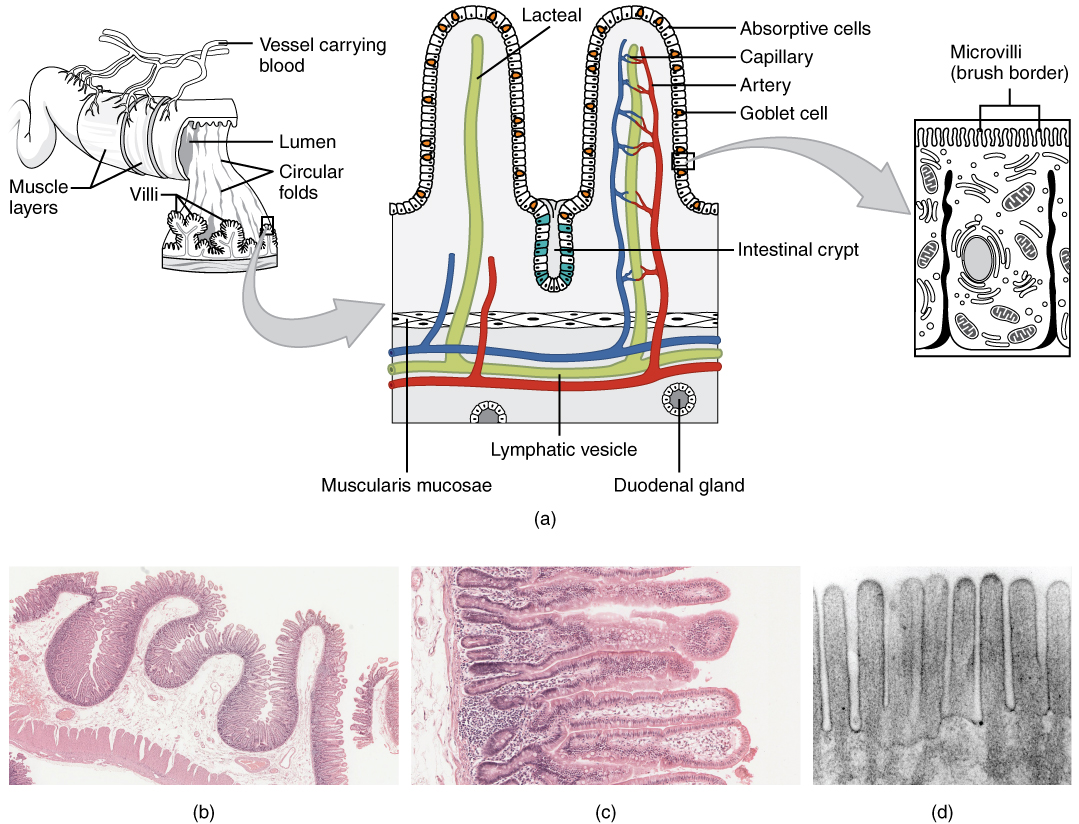

Areas of the GI tract can become eroded by hydrochloric acid and pepsin, which can result in an ulcer. Gastric ulcers are found in the stomach and duodenal ulcers can be found in the duodenum. When someone has an ulcer, they may experience burning pain 1-3 hours after eating, vomit blood, or have bloody stool. The helicobacter pylori bacteria plays a key role in the development of ulcers and it is thought that this bacteria burrows through the layers of mucus to expose the underlying sensitive layers of tissue. Some ulcers may be caused by the prolonged use of non-steroidal anti-inflammatory drugs.
When someone with celiac disease ingests gluten, a protein found in wheat, barley, and rye, it causes an immune reaction, which, over time can damage the villi of the small intestine. As the small intestine is the major site of nutrient absorption, this can result in the malabsorption of nutrients. Symptoms of celiac disease may include bloating, gas, chronic diarrhea, lactose intolerance, nausea, vomiting, abdominal pain, or loose, greasy, bulk stool
[1].
Movement through the Small Intestine
Two different types of muscular contractions, called peristalsis and segmentation, control the movement and mixing of food in the small intestine. Similar to what occurs in the esophagus and stomach, peristalsis is circular waves of smooth muscle contraction that propel food forward. Segmentation from circular muscle contraction slows movement in the small intestine by forming temporary “sausage link” type of segments that allow chyme to slosh food back and forth in both directions to promote mixing of the chyme and enhance absorption of nutrients (Figure 3.12 “Segmentation”). Almost all the components of food are completely broken down to their simplest units within the first 25 centimeters of the small intestine. Instead of proteins, carbohydrates, and lipids, the chyme now consists of amino acids, monosaccharides, and emulsified components of triglycerides.
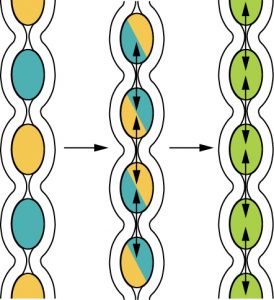
From the Small Intestine to the Large Intestine
The process of digestion is fairly efficient. Any food that is still incompletely broken down (usually less than ten percent of food consumed) and the food’s indigestible fibre content move from the small intestine to the large intestine (colon) through the ileocecal valve. The main task of the large intestine is to absorb much of the remaining water. Remember, water is present not only in solid foods and beverages, but the stomach also releases a few hundred milliliters of gastric juice, and the pancreas adds approximately 500 milliliters during the digestion of the meal. For the body to conserve water, excessive amounts of water mustn’t be lost in fecal matter. In the large intestine, no further chemical or mechanical breakdown of food takes place unless it is accomplished by the bacteria that inhabit this portion of the intestinal tract. The number of bacteria residing in the large intestine is estimated to be greater than 1014, which is more than the total number of cells in the human body (1013). This may seem rather unpleasant, but the great majority of bacteria in the large intestine are harmless and many are even beneficial.

From the Large Intestine to the Anus
After a few hours in the stomach, plus three to six hours in the small intestine, and about sixteen hours in the large intestine, the digestion process enters step four, which is the elimination of indigestible food matter as feces. Feces contain indigestible food components and gut bacteria (which comprise almost 50 percent of the content). It is stored in the rectum until it is expelled through the anus via defecation.
Summary of the Functions of the Digestive Organs
| Organ | Major functions | Other functions |
|---|---|---|
| Mouth |
|
|
| Pharynx |
|
|
| Esophagus |
|
|
| Stomach |
|
|
| Small intestine |
|
|
| Accessory organs |
|
|
| Large intestine |
|
|
| Data source: (“Digestive system processes and regulation,” 2022)[2] | ||
Summary of Enzymes and Hormones Involved in Digestion
| Category | Enzyme Name | Source | Substrate | Product |
|---|---|---|---|---|
| Salivary Enzymes | Lingual lipase | Lingual glands | Triglycerides | Free fatty acids, and mono- and diglycerides |
| Salivary Enzymes | Salivary amylase | Salivary glands | Polysaccharides | Disaccharides and trisaccharides |
| Gastric enzymes | Gastric lipase | Chief cells | Triglycerides | Fatty acids and monoacylglycerides |
| Gastric enzymes | Pepsin* | Chief cells | Proteins | Peptides |
| Brush border enzymes | Lactase | Small intestine | Lactose | Glucose and galactose |
| Brush border enzymes | Maltase | Small intestine | Maltose | Glucose |
| Brush border enzymes | Sucrase | Small intestine | Sucrose | Glucose and fructose |
| Brush border enzymes | Peptidases | Small intestine |
|
|
| Pancreatic enzymes | Carboxy-peptidase* | Pancreatic acinar cells | Amino acids at the carboxyl end of peptides | Amino acids and peptides |
| Pancreatic enzymes | Chymotrypsin* | Pancreatic acinar cells | Proteins | Peptides |
| Pancreatic enzymes | Elastase* | Pancreatic acinar cells | Proteins | Peptides |
| Pancreatic enzymes | Nucleases | Pancreatic acinar cells |
|
Nucleotides |
| Pancreatic enzymes | Pancreatic amylase | Pancreatic acinar cells | Polysaccharides (starches) | α-Dextrins, disaccharides (maltose), trisaccharides (maltotriose) |
| Pancreatic enzymes | Pancreatic lipase | Pancreatic acinar cells | Triglycerides that have been emulsified by bile salts | Fatty acids and monoacylglycerides |
| Pancreatic enzymes | Trypsin* | Pancreatic acinar cells | Proteins | Peptides |
| Data source: (“Chemical digestion and absorption,” 2022)[3] | ||||
| Hormone | Site of Production | Site of Action | Action |
|---|---|---|---|
| Gastrin | Stomach | Stomach | Stimulates secretion of HCl and pepsinogen and stimulates gastric motility
Promotes gastric mucosal cell proliferation |
| Secretin | Small intestine | Pancreas
Stomach |
Stimulates secretion of bicarbonate
Decreases gastric motility |
| Cholecystokinin (CCK) | Small intestine | Pancreas
Gall bladder Stomach |
Stimulates
Stimulates gall bladder contraction Slows gastric emptying |
| Gastric inhibitory peptide | Small intestine | Stomach
Pancreas |
Inhibits gastric acid secretion
Slows gastric emptying and stimulates insulin release |
| Data source: Thompson et al., 2014. [4]
|
|||
Everyday Connection

There has been significant talk about pre-and probiotic foods in the mainstream media. The World Health Organization defines probiotics as live bacteria that confer beneficial health effects on their host. They are sometimes called “friendly bacteria.” The most common bacteria labeled as probiotic is lactic acid bacteria (lactobacilli). They are added as live cultures to certain fermented foods such as yogurt. Prebiotics are indigestible foods, primarily soluble fibers, that stimulate the growth of certain strains of bacteria in the large intestine and provide health benefits to the host. A review article in the June 2008 issue of the Journal of Nutrition concludes that there is scientific consensus that probiotics ward off viral-induced diarrhea and reduce the symptoms of lactose intolerance.[5]
Expert nutritionists agree that more health benefits of pre-and probiotics will likely reach scientific consensus. As the fields of pre- and probiotic manufacturing and their clinical study progress, more information on proper dosing and what exact strains of bacteria are potentially “friendly” will become available.
You may be interested in trying some of these foods in your diet. A simple food to try is Kefir. Several websites such as BBC Good Food provide a list of tasty Kefir recipes you may be interested in trying. Kefir, a dairy product fermented with probiotic bacteria, can make a pleasant-tasting breakfast smoothie.
Media Attributions
- The trachea, the esophagus and its associated sphincters. © Open stax is licensed under a CC BY (Attribution) license
- The stomach and the small intestine © Open Stax is licensed under a CC BY (Attribution) license
- Sections of the small intestine © Open stax is licensed under a CC BY (Attribution) license
- The gallbladder © Open stax is licensed under a CC BY (Attribution) license
- The pancreas. © Open stax is licensed under a CC BY (Attribution) license
- Large intestine © Open stax is licensed under a CC BY (Attribution) license
- https://www.niddk.nih.gov/health-information/digestive-diseases/celiac-disease/symptoms-causes ↵
- Table accessed for free at: https://openstax.org/books/anatomy-and-physiology-2e/pages/23-2-digestive-system-processes-and-regulation ↵
- Table modified from one accessed for free at: https://openstax.org/books/anatomy-and-physiology-2e/pages/23-7-chemical-digestion-and-absorption-a-closer-look ↵
- Thompson JL, Manore MM, Vaughan LA, Gottschall-Pass K, MacLellan DL. The Science of Nutrition. Canadian Edition. Likach N, Haggert C, Bhatt N, editors. Upper Saddle River, New Jersey, USA: Pearson Education Inc; 2014. ↵
- Farnworth ER. The Evidence to Support Health Claims for Probiotics. J Nutr. 2008; 138(6), 1250S–4S. http://jn.nutrition.org/content/138/6/1250S.long. Accessed September 22, 2017. ↵

